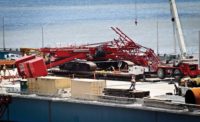
Separate investigations by the U.S. Occupational Safety & Health Administration and the contractor Kokosing into the cause of the Jan. 19 Interstate 75 overpass collapse near Cincinnati will likely take months. But an industry expert suggests that adequate engineering documentation before the demolition of the overpass might have prevented the accident, in which the middle span fell onto I-75 and killed a worker.
Crews with Kokosing, which holds a $91-million contract to rebuild the Hoppell Interchange, cleared the debris and repaired the highway within 24 hours of the Monday night accident. Kokosing had been removing the overpass span by span.
Linwood "Woody" Howell, an engineer with XR Structural, which inspects bridges for the Texas Dept. of Transportation, says a close look at the photos seems to indicate the structure was a cantilevered continuous bridge, with two side spans cantilevering out to support the middle span over the highway. In that case, "it would be a fatal mistake to demo starting from the side spans, instead of the middle," he says. "It makes sense in terms of efficiency to remove spans in sequence." Today, more typical overpasses would have direct supports for each span, he says.
Howell adds, "Any engineer looking at the structure would have known about this structure type where you can't take the side spans out before the middle span."
In a statement to ENR, Kokosing said, "We are deeply saddened at the loss of our friend and co-worker Brandon Carl. Brandon was a part of the Kokosing family for over 10 years. During that time, he worked on many projects, was an experienced and respected foreman, and made numerous friends among his many co-workers. We ask the construction industry to join us in sending prayers to his family.
"We are cooperating closely with investigators from [the Ohio Dept. of Transportation, OSHA] and our own independent experts to determine the cause of this tragic incident."
Steve Medlock, an OSHA construction compliance officer, says the agency does have specifications for demolition. "One part, which is really specific, says that, prior to permitting employees to start demolition operations, an engineering survey should be conducted."
Agencies such as TxDOT do require engineering documentation for critical bridge components such as overhangs, shoring or erection formwork, says Howell. "Maybe DOTs should do that on demolitions also, at least for critical cases," he suggests, noting DOTs vary in standards for engineering documentation.
Jamey Barbas, global practice leader of major structures for The Louis Berger Group, concurs. "It's on a state-by-state basis, what the owners ask for," she says, noting that scrutiny of planned demolitions related to signature bridges can be very high. "But if you have a 'vanilla' structure, that's when [demo crews] might get into trouble."




Post a comment to this article
Report Abusive Comment